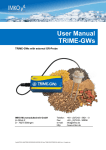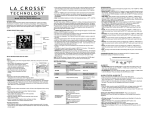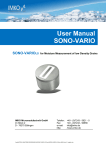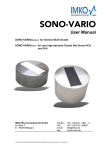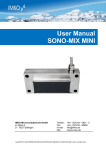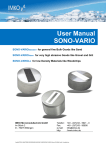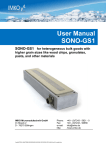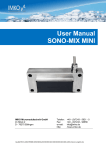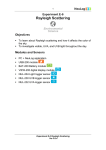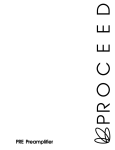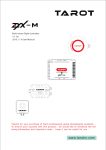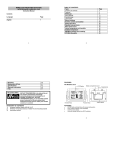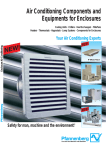Download SONO-GW User Manual
Transcript
SONO-GW User Manual SONO-GW with external GR-Probe IMKO Micromodultechnik GmbH Im Stöck 2 D - 76275 Ettlingen Telefon: Fax: e-mail: http: I:\publik\TECH_MAN\TRIME-SONO\ENGLISH\SONO-GW\SONO-GW MAN-Vers1_0-english Entwurf!!.doc +49 - (0)7243 - 5921 - 0 +49 - (0)7243 - 90856 [email protected] //www.imko.de 2/44 User Manual for SONO-GW As of 06. February 2013 Thank you for buying an IMKO moisture probe. Please carefully read these instructions in order to achieve best possible results with your SONO-GW in-line moisture measurement system. Should you have any questions or suggestions regarding your new system after reading, please do not hesitate to contact our authorised dealers or IMKO directly. We will gladly help you. List of Content: 1. Instrument Description SONO-GW ........................................................................................ 4 1.1.1. The patented TRIME® TDR-Measuring Method........................................................... 4 1.1.2. TRIME® compared to other Measuring Methods ......................................................... 4 1.1.3. Areas of Application with SONO-GW and the GR-probe ............................................. 4 1.2. Mode of Operation............................................................................................................. 5 1.2.1. Measurement value collection with pre-check, average value and filtering................... 5 1.2.2. Temperature Measurement......................................................................................... 5 1.2.3. Temperature compensation when working at high temperatures ................................. 5 1.2.4. Analogue Outputs ....................................................................................................... 5 1.2.5. The serial RS485 and IMP-Bus interface .................................................................... 6 1.2.6. The IMP-Bus as a user friendly network system .......................................................... 6 1.2.7. Error Reports and Error Messages.............................................................................. 7 1.3. Connectivity to SONO-GW ................................................................................................ 7 1.3.1. How to configurate SONO-probes to appropriate operating and calibration parameters? ............................................................................................................................. 8 1.4. 2. 3. Instrumentation of SONO-GW with GR-Probe and SONO-VIEW ........................................ 9 1.4.1. Electrical connection diagram with analogue outputs and SONO-VIEW .................... 10 1.4.2. Connection Plug and Plug Pinning ............................................................................ 10 1.4.3. Analogue Output 0..10V with a Shunt-Resistor.......................................................... 11 Installation in Practice.......................................................................................................... 12 2.1.1. Monitoring during grain delivery ................................................................................ 13 2.1.2. Manual control of the grain dryer............................................................................... 13 2.1.3. Automatic control of the grain dryer........................................................................... 13 2.1.4. Best installation conditions for SONO-GW inside a tunnel dryer ................................ 13 2.1.5. Best installation conditions for SONO-GW inside a rotary dryer................................. 14 The GR-Probe Installation .................................................................................................... 15 3.1.1. 3.2. Exchange of a GR-Probe.......................................................................................... 16 Installation of measurement transformer SONO-GW ........................................................ 17 4. 5. 3/44 Initial operation and installation .......................................................................................... 18 4.1. Adjustment Guidelines for relative Moisture Measurements in the heating Zone ............... 18 4.2. Adjustments for initial operation ....................................................................................... 18 4.2.1. Adjustment for plants with several SONO-GWs......................................................... 19 4.2.2. Selection of the calibration curve Cal1 to Cal15......................................................... 19 4.2.3. Calibration curves with or without temperature compensation.................................... 20 4.2.4. Selection and application of the reference method .................................................... 21 4.2.5. Recording measurement data in trial operation ......................................................... 22 4.2.6. Setting the calibration curve (adjustment).................................................................. 22 4.2.7. An example for wheat ............................................................................................... 23 Configuration of the Measure Mode .................................................................................... 24 5.1.1. Operation Mode CA and CF at non-continuous Material Flow.................................... 24 5.1.2. Average Time in the measurement mode CA and CF ................................................ 26 5.1.3. Filtering at material gaps in mode CA and CF ........................................................... 26 5.1.4. Mode CC – automatic summation of a moisture quantity during one batch process . 27 5.2. Calibration Curves Cal1 to Cal15 ..................................................................................... 29 5.3. Creating a linear Calibration Curve for a specific Material................................................. 32 5.3.1. 5.4. 6. 7. Nonlinear calibration curves ...................................................................................... 32 Connection of the RS485 to the SM-USB Module ............................................................ 34 Quick guide for the Software SONO-CONFIG ..................................................................... 37 6.1.1. Scan of connected SONO-GWs on the RS485 interface ........................................... 37 6.1.2. Configuration of Measure Mode ................................................................................ 38 6.1.3. Analogue outputs of the SONO-GW .......................................................................... 38 6.1.4. Selection of the individual Calibration Curves............................................................ 39 6.1.5. Test run in the respective Measurement Mode .......................................................... 40 6.1.6. Basic Balancing in air and dry glass beads ............................................................... 41 6.1.7. Execution of the basic calibration for SONO-GW....................................................... 42 Technical Data SONO-GW .................................................................................................... 43 4/44 1. Instrument Description SONO-GW 1.1.1. The patented TRIME® TDR-Measuring Method The TDR technology (Time-Domain-Reflectometry) is a radar-based dielectric measuring procedure at which the transit times of electromagnetic pulses for the measurement of dielectric constants, respectively the moisture content are determined. SONO-GW consists of the measurement transformer SONO-GW and the GR-probe head. An integrated TRIME TDR measuring transducer is installed into the SONO-GW casing. A high frequency TDR pulse (1GHz), passes along wave guides and generates an electro-magnetic field around these guides and herewith also in the material surrounding the probe. Using a new patented measuring method, IMKO has achieved to measure the transit time of this pulse with a resolution of 1 picosecond (1x10-12), consequently determine the moisture and the conductivity of the measured material. The established moisture content, as well as the conductivity, respectively the temperature, can either be uploaded directly into a SPC via two analogue outputs 0(4) ...20 mA or recalled via a serial RS485 interface. 1.1.2. TRIME® compared to other Measuring Methods In contrary to conventional capacitive or microwave measuring methods, the TRIME® technology (Time-Domain-Reflectometry with Intelligent Micromodule Elements) offers precise measurement results which means more reliability at the production. TRIME-TDR technology operates in the ideal frequency range between 600MHz and 1,2 GHz. Capacitive measuring methods (also referred to as Frequency-Domain-Technology) , depending on the device, operate within a frequency range between 5MHz and 40MHz and are therefore prone to interference due to disturbance such as the temperature and the mineral contents of the measured material. Microwave measuring systems operate with high frequencies >2GHz. At these frequencies, nonlinearities are generated which require very complex compensation. For this reason, microwave measuring methods are more sensitive in regard to temperature variation. The modular TRIME technology enables a manifold of special applications without much effort due to the fact that it can be variably adjusted to many applications. 1.1.3. Areas of Application with SONO-GW and the GR-probe The SONO-GW with the 2-rod GR-probe is suited for measuring in different materials directly inside a grain dryer. The GR rod-probe requires a good flowability of the measured material in order to ensure that the material lies close to the rods when the material is flowing. For applications with badly flowing materials, the surface probes SONO-GS1 or SONO-VARIO LD could be a better solution. The GR-probe head consists of PEEK. The special 2 meter long radar cable is made of PTFA. The GR-probe and the cable withstands temperatures up to 130° Celsius. But the temperature range for the SONO-GW measurement transformer should not be higher than 80°C. 5/44 1.2. Mode of Operation 1.2.1. Measurement value collection with pre-check, average value and filtering SONO-GW measures internally at a rate of 100 measurements per seconds and issues the measurement value at a cycle time of up to 200 milliseconds at the analogue output. In these 200 milliseconds a probe-internal pre-check of the moisture values is already carried out, i.e. only plausible and physically pre-averaged measurement values are be used for the further data processing. This increases the reliability for the recording of the measured values to a downstream control system significantly. In the Measurement Mode CS (Cyclic-Successive), an average value is not accumulated and the cycle time here is 200 milliseconds. In the Measurement Mode CA and CF (Average), not the momentarily measured individual values are directly issued, but an average value is accumulated via a variable number of measurements in order to filter out temporary variations. These variations can be caused by inhomogeneous moisture distribution in the material surrounding the sensor head. The delivery scope of SONO-GW includes suited parameters for the averaging period and a universally applicable filter function deployable for currently usual applications. The time for the average value accumulation, as well as various filter functions, can be adjusted for special applications. 1.2.2. Temperature Measurement A temperature sensor is installed in the rod tip of the GR probe which establishes the measurement of the material temperature. The temperature can optionally be issued at the analogue output 2. 1.2.3. Temperature compensation when working at high temperatures Because the SONO-GW measurement transformer works in other temperature ranges as the GRprobe inside the dryer, it is necessary to compensate the electronic separately from the GR-probe. SONO-GW offers two possibilities for temperature compensation. A) Temperature compensation of the internal SONO-electronic Despite the SONO-GW electronic shows a generally low temperature drift, it is necessary to compensate a temperature drift in applications for measuring moisture inside a grain dryer. With this method of temperature compensation, a possible temperature drift of the SONO-electronic can be compensated. For standard applications in grain drying the compensation parameter is pre-setted to TempComp=0.2. For special applications it could be necessary to adjust this parameter. But it is to consider that it is necessary to make a Basic-Balancing of the SONO-GW in air and dry glass beads, if the parameter TempComp is changed to another value. The parameter TempComp can be changed with the software tool SONO-CONFIG, in the menu "Calibration" and the window "TemperatureCompensation". B) Temperature compensation for the measured material Water and special materials like maize, wheat and others, show a dependency of the dielectric permittivity when using SONO-GW at high temperature ranges. The dielectric permittivity is the raw parameter for measuring water content with SONO-GW. If special materials show this temperature drift, than it could be necessary to use a more elaborate temperature compensation. SONO-GW offers the possibility to set special temperature compensation parameters for every calibration curve Cal1 of Cal15 (see chapter “Selection of the individual calibration curve”). 1.2.4. Analogue Outputs The measurement values are issued as a current signal via the analogue output. With the help of the service program SONO-CONFIG, the SONO-GW can be set to the two versions for 0..20mA or 6/44 4..20mA. Furthermore, it is also possible to variably adjust the moisture dynamic range e.g. to 0-10%, 0-20% or 0-30%. For a 0-10V DC voltage output, a 500R resistor can be installed in order to reach a 0..10V output. Analogue Output 1: Moisture in % (0…20%, variable adjustable) Analogue Output 2: Temperature 0….100°C, variable adjustable For the analogue outputs 1 and 2 there are thus two adjustable options: Analog Output: (two possible selections) 0..20mA 4..20mA Output Channel 1 and 2: (three possible selections) 1. Moist, Temp. Analogue output 1 for moisture, output 2 for temperature. or 2. Moist, Conductivity Analogue output 1 for moisture, output 2 for conductivity in a range of 0..20dS/m. or 3. Moist, Temp/Conductivity Analogue output 1 for moisture, output 2 for both, temperature and conductivity with an automatic current-window change. For analogue output 1 and 2 the moisture dynamic range and temperature dynamic range can be variably adjusted. The moisture dynamic range should not exceed 100% Moisture Range: Maximum: e.g. 20 for sand (Set in %) Minimum: 0 Temp. Range: Maximum: 100 °C Minimum: 0 °C 1.2.5. The serial RS485 and IMP-Bus interface SONO-GW is equipped with a standard RS485 as well as the IMP-Bus interface to set and readout individual parameters or measurement values. An easy to implement data transfer protocol enables the connection of several sensors/probes at the RS485-Interface. In addition, the SONO-GW can be directly connected via the modul SM-USB to the USB port of a PC, in order to adjust individual measuring parameters or conduct calibrations. Please consider: The initial default setting of the serial interface is pre-setted for the IMP-Bus. To operate with the RS485 inside the SONO-GW, it is necessary to switch and activate the RS485 interface with help of the modul SM-USB. In the download area of IMKO´s homepage www.imko.de we publish the transmission protocol of SONO-GW. 1.2.6. The IMP-Bus as a user friendly network system With external power supply on site for the SONO probes, a simple 2-wire cable can be used for the networking. By use of 4-wire cables, several probes can be also supplied with power. Standard RS485-interfaces cause very often problems! They are not galvanically isolated and therefore raises the danger of mass grindings or interferences which can lead to considerably security problems. An RS485 network needs shielded and twisted pair cables, especially for long distances. Depending on the topology of the network, it is necessary to place 100Ohm termination resistors at sensitive locations. In practice this means considerable specialist effort and insurmountable problems. The robust IMP-Bus ensures security. SONO-probes have in parallel to the standard RS485 interface the robust IMP-Bus which is galvanically isolated which means increased safety. The serial data line is isolated from the probe´s power supply and the complete sensor network is therefore 7/44 independent from single ground potentials and different grid phases. Furthermore the IMP-Bus transmit its data packets not as voltage signals, but rather as current signals which also works at already existing longer lines. A special shielded cable is not necessary and also stub lines are no problem. 1.2.7. Error Reports and Error Messages SONO-GW is very fault-tolerant. This enables failure-free operation. Error messages can be recalled via the serial interface. 1.3. Connectivity to SONO-GW 8/44 1.3.1. How to configurate SONO-probes to appropriate operating and calibration parameters? SONO-GW is initially adjusted for the application for grain drying with the calibration curve Cal2, operation mode CF and 3 seconds average time. The analogue outputs are adjusted to 4..20mA. With this pre-adjustment SONO-GW can be installed direct in the heating zone, without further adjustments. For operation at the discharge hopper where an absolute moisture value is important, SONO-GW has to be adjusted to a suitable calibration curve Cal-x, depending on grain type and possibly to a zerooffset, depending on installation place. There are two possibilities to configurate and adjust a SONO-probe: A: Online Configuration via SONO-VIEW With the stand-alone device SONO-VIEW it is possible to configurate SONO-probes online to an appropriate operating mode, without the need to connect the SONO-probe to a PC. The operating mode depends on the application like the moisture measurement under a silo flap, inside a dryer or mixer or on a conveyor belt. The SONO-probe can be adapted via the SONO-VIEW to the appropriate operating mode like: cyclic measurement, averaging, filtering, cumulating and other powerful operating parameters. Furthermore it is possible to select a calibration curve inside a SONO-probe with zerooffset setting. All configuration parameters are stored in a non-volatile memory inside the SONOprobe. This ensures that the analog output (e.g. 4-20mA) of the SONO-probe which could be connected in parallel to a PLC, responds directly to the setted configuration parameters. B: Configuration via the SM-USB The SONO-probe is connected via the SM-USB and the RS485-interface to a PC. With help of the software tool SONO-CONFIG it is possible to configurate SONO-probes to an appropriate operating mode. The operating mode depends on the application like the moisture measurement under a silo flap, inside a mixer or on a conveyor belt. The SONO-probe can be adapted to the appropriate operating mode like: cyclic measurement, averaging, filtering, cumulating and other powerful operating parameters. Furthermore it is possible to select a calibration curve inside a SONO-probe with zerooffset setting. All configuration parameters are stored in a non-volatile memory inside the SONOprobe. So the analog output (e.g. 4-20mA) of the SONO-probe which could be connected in parallel to a PLC, responds directly to the configuration parameters. 9/44 1.4. Instrumentation of SONO-GW with GR-Probe and SONO-VIEW The moisture display unit SONO-VIEW can be optionally connected via the IMP-Bus. 10/44 1.4.1. Electrical connection diagram with analogue outputs and SONO-VIEW 1.4.2. Connection Plug and Plug Pinning SONO-GW is supplied with a 10-pole MIL flange plug. . 11/44 Assignment of the 10-pole MIL Plug and sensor cable connections: Plug-PIN Sensor Connections Lead Colour A +7V….28V Power Supply red B 0V Blue D 1. Analogue Positive (+) Moisture Green E 1. Analogue Return Line (-) Moisture yellow F RS485 A white G RS485 B brown C (rt) IMP-Bus grey/pink J (com) IMP-Bus blue/red K 2. Analogue Positive (+) Pink E 2. Analogue Return Line (-) Grey H Screen (is grounded at the sensor. The plant must be properly grounded!) transparent Power Supply 1.4.3. Analogue Output 0..10V with a Shunt-Resistor There are PLC´s which have no current inputs 0..20mA, but voltage inputs 0..10V. With the help of a shunt resistor with 500 ohm (in the delivery included) it is possible to generate a 0..10V signal from the current signal 0..20mA. The 500 ohm shunt resistor should be placed at the end of the line resp. at the input of the PLC. Following drawing shows the circuit principle. Please note: The analogue output of SONO-GW must be set to 0 to 20mA! 12/44 2. Installation in Practice There is a variety of applications for the SONO-GW. On the one hand, it can be used for monitoring the moisture of delivered grain. On the other, it can assist or automate the grain-drying process. The conditions for installation depend heavily on the characteristics of the plant. The optimum location must be sought for each case individually. The following guidelines will be of assistance. The appropriate position of the calibration curve must be selected depending on the grain in question and its density. 13/44 2.1.1. Monitoring during grain delivery The SONO-GW offers possibilities of continually measuring the moisture of the grain while it is being delivered. This provides a moisture profile that can be recorded by a PC or a line printer. The display unit SONO-VIEW can be connected as well for showing the values at any given moment. Legal regulations prevent SONO-GW being used instead of instruments that have been officially calibrated and authorised for goods traffic. The single measurements, usually based on very small samples, from such instruments are supplemented by the continual, considerably more representative range of measurements taken by the SONO-GW. This results in better quality control and enhances transparency. 2.1.2. Manual control of the grain dryer In the case of manual or semi-automatic dryer-control systems, using the SONO-GW in conjunction with the display unit SONO-VIEW can significantly improve drying results. 2.1.3. Automatic control of the grain dryer This involves connecting the SONO-GW to the controller’s actual-value input. It is ideal to use several SONO-GW in this case. The highest level of drying efficiency can be achieved in automatic control systems. 2.1.4. Best installation conditions for SONO-GW inside a tunnel dryer Near the material feed? Although it is possible to measure here the moisture, the distance to the cooling zone is so far, that a precise control and regulation of moisture with the PLC is not possible. Furthermore it could be possible that grains are frozen, but SONO-GW cannor detect frozen water. So an installation here is not recommended. At the end of the heating zone at the transition to the cooling zone? Here it´s already too late to react and control the moisture with the PLC. Furthermore the material could have not best homogeneity. So an installation here is also not recommended. At the beginning of the heating zone: Here the conditions are ideal. The grain is not too hot and the distance to the cooling zone is sufficient for the PLC to regulate for the correct moisture content. With a measured moisture value it is possible to calculate the amount of water reduction. Depending on grain type like maize, wheat or rye, a suitable calibration curve has to be adjusted inside the SONO-GW. At this installation place not the absolute moisture stands in the foreground. Instead it is more important to measure relative moisture values together with an adjusted temperature compensation inside the moisture probe, so that the probe measure precise relative moisture values independent on temperature values. The adjusted calibration curve inside the SONO-GW has to be select with TC (with Temperature compensation, see chapter “Calibration curves”). Calibration curves with TC use the temperature sensor inside the rod tip of the GR-probe for compensation of temperature changes in the heating zone. At very large dryer systems it is recommended to use two SONO-GWs in the heating zone to achieve best possible results. Inside the cooling zone? An installation here is not recommended due to uneven conditions inside this zone. At the discharge hopper: Here an installation is recommended for controlling the final result after drying and cooling. For displaying correct moisture values it is to taken into account that a suitable calibration curve is to adjust, depending on grain type. A zero offset of SONO-GW could be also necessary due to installation place. If the outfeed is continually and the GR-probe is continually covered with grain, then the calibration curve has to be selected “with TC” (Temperature Compensation). However if the outfeed is batch by batch, then the calibration curve has to be selected “without TC”, because the temperature sensor at the rod tip of the GR probe measures most of the time the air temperature, not the grain temperature, which would lead to measurement failures (see chapter “Calibration Curves”). 14/44 If only one sensor is installed at the discharge hopper and no sensor in the heating zone, then it is necessary that the wet grain moisture has nearly identical values. In this case a control and regulation with a PLC could be possible. If the feeded grain shows larger deviations then a precise control is impossible with only one system sensor at the discharge. 2.1.5. Best installation conditions for SONO-GW inside a rotary dryer Recommended is an installation in the funnel, where the material is transported agian from bottom to top and where it is secured, that the GR-probe is continually covered with grain. 15/44 3. The GR-Probe Installation The GR-probe comprises a cylindrical probe-head made of a heat-resistant special-purpose plastic that has a threaded bore for mounting on silo- or housing walls. The actual measuring probe consists of two parallel, steel prongs that are set into this probe head. The area relevant for moisture measurement surrounds the prongs. Please note: GR-probes and SONO-GW measurement transformers must not be exchanged amongst each other. Please note the serial number, the GR-probe and the SONO-GW measurement transformer must have the same serial number! The probe must be fitted in such a way that the prongs protrude into the interior of the dryer or silo. Reliable measurements can only be ensured when the prongs are fully immersed in grain. Therefore, a location for installation must be chosen where ... the full length of the prongs is covered by and in contact with grain. hollow spaces cannot occur in the direct vicinity of the probe prongs (at least 5 cm from the prongs). the prongs are in the stream of exhaust (outlet) air. The temperature compensation fails in the inlet (heated) air zone. metallic objects, e.g. channelling panels in dryers, are at least 5 cm from the prongs. Measurement anomalies caused by metallic objects can be eliminated by offset-correction (see following schematic diagram). no temperatures above 120°C occur. In continuous-flow dryers, the best place for optimum regulation is at the end of the drying zone. Regulation can, of course, be further improved by installing additional probes in the drying zone and at the end of the cooling zone. The final moisture content at the end of the drying process can be best monitored when a probe is fitted at the discharge point as well. 16/44 Exhaust roof a sureme me nt d iel f as me grain flow TRIME-GR ur em ent field ventilation roof grain flow A schematic diagram of a roof-dryer (exhaust side !) with a fitted probe. The elliptical area represents the measuring range of the GR-probe. The field of measurement diminishes the greater the distance from the probe. Nevertheless, the measurement range can extend into the area of the ventilation roofs where there is no grain. This means that the reading includes a proportion of air in the measurement volume and thus the resultant relative water content is too low. This constant, location-specific offset can be compensated for by a zero offset-correction. In the case of rotary dryers and hatch points, the probe should be fitted where the grain conveying speed is lowest. We recommend installation in the reservoir or close to the discharge point. Probe installation can be carried out in the following steps: 1. Drill a 72 mm – diameter hole in the container wall or cut out a square hole using an angle-grinder. 2. Secure the aluminium flange to the wall with four M5 screws (Cut M5 threads into the wall). 3. Screw the probe into the flange as far as possible. 4. Use the locknut to secure the probe in such a way that the prongs are set slight past vertical (10° to 15°). Important: Under no circumstances is the probe to be connected to the instrument while being installed, as the electronics may be destroyed otherwise! 3.1.1. Exchange of a GR-Probe In the event of a mechanical defect it could be necessary to exchange the GR-probe. After connecting a new GR-probe, it is necessary to make a basic balancing with the new GR-probe in air (see chapter “Basic balancing…”. This basic balancing can be made via the modul SM-USB and the software tool SONO-CONFIG or directly online via the module SONO-VIEW. 17/44 3.2. Installation of measurement transformer SONO-GW The SONO-GW must be installed in the vicinity of the probe as the length of the probe cable is only 2.5 m for technical reasons. The temperature of the surroundings should, however, not exceed 80°C (ideal: outgoing-air end, external wall of dryer). The instrument can be mounted at a suitable point with screws through the two diagonally-opposed holes in the casing. An aluminium mounting-plate is available as an optional extra. If the instrument is to be mounted on a surface whose temperature exceeds 80°C, it must be fitted using spacing bolts (min. 8 mm) to prevent the direct transfer of heat from the wall to the instrument casing. The instrument should not permanently be exposed to direct precipitation, although it is specified to IP65. For outdoor usage it should be mounted below a protection roof, e. g. a horizontal mounted plate. Distance 8 mm 18/44 4. Initial operation and installation 4.1. Adjustment Guidelines for relative Moisture Measurements in the heating Zone Please read the detailed description first and subsequently use these guidelines as a checklist for adjustments. 1. Extract samples from as close as possible to the probe. 2. Select calibration curve with help of SONO-VIEW or via the module SM-USB. Note: SONO-GW is initially adjusted for the application for grain drying with the calibration curve Cal2. The analogue outputs are adjusted to 4..20mA. With this pre-adjustment SONOGW can be installed direct in the heating zone, without further adjustments. For operation at the discharge hopper where an absolute moisture value is important, SONO-GW has to be adjusted to a suitable calibration curve Cal-x, depending on grain type and possibly to a zerooffset, depending on installation place. 3. Start up the dryer for the trial run, extract reference samples continuously approx. every half hour and enter the reading together with the switch position in the adjustment protocol. 4. Determine the difference between the target and the actual value and if necessary adjust the offset of the selected calibration curve. 5. Repeat this procedure for different grain types. 6. As soon as the grain moisture has fallen to 3% above the target value (for continuousflow dryers when the start-up phase is finished), extraction of reference samples must be stepped up to take place at 15 minute intervals. 7. When drying is finished, the correct setting on the product selection switch must be determined from the last reference values (less than 3% above the target value). 4.2. Adjustments for initial operation The term “adjustment” refers, in this case, to the correct setting of the calibration curve and zero offset depending on grain type and installation place where an absolute moisture value with an accuracy of +-0,3% is important. The SONO-GW can only be adjusted when installed in the plant as the location and the bulk density of the grain have a significant influence on moisture measurement. Adjustment must be carried out separately for every dried product. Moisture measurement is dependent on the following parameters: Location (e.g. metallic objects within the field of measurement) Bulk density of the grain Type of grain (product) As soon as one of these parameters changes, another calibration curve and adjustment must be chosen. If all possible grain types are adjusted, it is only necessary to select the right calibration curve when changing the grain type in the plant. 19/44 4.2.1. Adjustment for plants with several SONO-GWs When the plant is only equipped with one SONO-GW, adjustments are made for the installationrelated influences at the same time as those for the grain product. Exactly the same procedure can be followed as described in the next sections. In plants with several probes, it may also be necessary to correct the deviations between the SONOGWs themselves. This is good policy only when all the SONO-GWs are to give an absolute measurement. If the installation-related constant deviation of 1-2% presents no problem, it is sufficient to make an adjustment using the final control probe, e.g. the SONO-GW at the discharge point. To carry out the extended adjustment for all SONO-GWs, three steps must be taken: 1. Firstly, the SONO-GW which is most important for the drying operation must be selected via the SONO-VIEW or via the module SM-USB. The probe at the discharge point, for example, is a potential candidate. Whichever one SONO-GW is chosen, it must be possible to extract samples directly at the point where this probe is located. 2. This SONO-GW must be adjusted. Simultaneously, the measurement data for all the other instruments must be gathered, too. The samples for this should be extracted from as near to the probe as possible. 3. Using the differences between the readings of each of the instruments, the SONO-GW can be adjusted with help of the SONO-VIEW or via the module SM-USB and a connected PC. 4.2.2. Selection of the calibration curve Cal1 to Cal15 Up to 15 different calibration curves (CAL1 ... Cal15) are stored inside the SONO-GW. They can be activated in two ways: A: With the stand alone module SONO-VIEW the calibration curve can be selected and activated. B: A calibration curve (Cal1. .15) can be activated with the module SM-USB which is connected via a PC. In the menu "Calibration" and in the window “Material Property Calibration" by selecting the desired calibration curve (Cal1...Cal15) and with using the button “Set Active Calib”. The finally desired and possibly altered calibration curve (Cal1. .15) which is activated after switching on the probes power supply will be adjusted with the button "Set Default Calib”. Moisture measurement is dependent on the following parameters: Location (e.g. metallic objects within the field of measurement) Bulk density of the grain Type of grain (product) The SONO-GW can only be adjusted when installed in the plant as the location and the bulk density of the grain have a significant influence on moisture measurement. Adjustment must be carried out separately for every dried product. Moisture measurement is dependent on the following parameters: Location (e.g. metallic objects within the field of measurement) Bulk density of the grain Type of grain (product) As soon as one of these parameters changes, another calibration curve and adjustment must be chosen. If all possible grain types are adjusted, it is only necessary to select the right calibration curve when changing the grain type in the plant. 20/44 4.2.3. Calibration curves with or without temperature compensation Installation at the beginning of the heating zone: Depending on grain type like maize, wheat or rye, a suitable calibration curve has to be adjusted inside the SONO-GW. At this installation place not the absolute moisture stands in the foreground. Instead it is more important to measure relative moisture together with an adjusted temperature compensation for the probe, so that the probe measure precise independent on temperature values. The adjusted calibration curve inside the SONO-GW has to be select with TC (with Temperature compensation, see chapter “Calibration curves”). Calibration curves with TC use the temperature sensor inside the rod tip of the GR-probe for compensation of temperature changes in the heating zone. Installation at the discharge hopper: For displaying correct moisture values it is to taken into account that a suitable calibration curve is to adjust, depending on grain type. A zero offset of SONOGW could be also necessary due to installation place. If the outfeed is continually and the GR-probe is continually covered with grain, then the calibration curve has to be selected “with TC” (Temperature Compensation). However if the outfeed is batch by batch, then the calibration curve has to be selected “without TC”, because the temperature sensor at the rod tip of the GR probe measures most of the time the air temperature, not the grain temperature, which would lead to measurement failures SONO-GW can be easily installed in the heating zone with the pre-setted parameters. It measures moisture values with an accuracy of +-0,3%. If SONO-GW is installed at the discharge hopper it is necessary to make a precise adjustment for every selected calibration curve. The following charts (Cal.1 .. 15) show different selectable calibration curves which are stored inside the SONO-GW. Plotted is on the y-axis the gravimetric moisture (MoistAve) and on the x-axis depending on the calibration curve the associated radar time tpAve in picoseconds. With the software SONO-CONFIG the radar time tpAve is shown on the screen parallel to the moisture value MoistAve (see "Quick Guide for the Software SONO-CONFIG). 21/44 Calibration Curve Recommended for grain type Cal1 Maize, without TC (Temperature Compensation) Installation at the discharge hopper. The outfeed is batch by batch and it is not secured, that the GRprobe is continually covered with grain. Cal2 Maize, with TC A: Installation at the beginning of the heating zone, where the GR-probe is continually covered with grain. (pre-setted after delivery) Bulk density Application B: Installation at the discharge hopper. The outfeed is continually and the GR-probe is continually covered with grain. Cal3 Weizen, ohne TK siehe Cal1 Cal4 Weizen, mit TK A oder B Cal5 Cal6 Cal7 Cal8 Cal9 Cal10 Cal11 Cal12 Cal13 Cal14 Cal15 4.2.4. Selection and application of the reference method In order to adjust the SONO-GW for precise absolute measurements at the discharge, an off-line measurement method must be available to serve as a reference. It must provide a high degree of absolute precision and function with large sample volumes Most commercially available grain-moisture measuring systems leave a great deal to be desired regarding both of these aspects! The SONO-GW measures the average value continuously over a volume of 1-2 litres. In moving grain, the measurement volume acquired in the averaging time increases many times over. It therefore requires a lot of time and effort to check this very representative value with a reference instrument that shows a sample quantity in the millilitre range. There are also factors that can affect measurement, 22/44 such as temperature and conductivity, that can be ignored when using SONO-GW due to the TDR radar method of measurement. Thus, the most suitable method for determining the exact moisture of the grain is to use a drying oven. Here, too, the sample volume is of decisive importance and should be at 0.5 litres. When extracting the sample and taking reference measurements, the following must be observed: The samples for the reference measurements should be extracted from as close as possible to the probe. The distribution of moisture in the grain dryer can vary greatly. When using a calibrated instrument with small sample volumes, several samples must be extracted and their arithmetical average calculated. Please note that calibrated instruments can also produce incorrect measurements that can lie between 2% in the lower and even 5% in the upper moisture range. After the dryer or the silo has been filled, the SONO-GW moisture value must show a valid reading. 4.2.5. Recording measurement data in trial operation The selection of the calibration curve can only be adjusted in real operation or in realistic trial operation. The following description is based on the implementation of the SONO-GW at the discharge, in the delivery or in the storage area. As a general rule, only the moisture range close to the reference input is of significance for trial operation, i.e. when determining the switch position for maize, checking should be done at about 15%. It is more important that the SONO-GW is exactly correct in the lower area of measurement. It is of less importance whether SONO-GW measures 26% instead of 28% in the upper range! When extracting a sample or checking the lower reference input (e.g. 15% ), a single sample is of course insufficient. A single sample, possibly even extracted from quite a different point than in the direct vicinity of the probe, is not at all representative, i.e. several samples must be taken directly at the probe and averaged! At the start of trial operation, the suitable calibration curve can be set. When all the preparations for extracting samples and measuring them have been made, the grain dryer can be started up. Now, a sample of grain must be taken continuously, ideally every 15 minutes. The SONO-GW reading and the selected calibration curve are to be noted simultaneously with every extracted sample. This is compared with the appropriate offline-determined reference value, which is also to be noted. As soon as the moisture is near the target moisture, the calibration curve should be set to the best possible value, which is the nearest to the reference value. In the following you will find a ready-to-use form for entering the measurements. Where continuous-flow dryers are concerned, at least 10 to 20 measurements should be available in the range between the minimum and maximum permissible moisture content after drying. The measurements from the still very damp discharged grain during the charge phase should be noted but not used for the purposes of adjustment. For rotary dryers, only the measurements take towards the end of the drying process are of relevance to adjustment. Here, too, at least 10 measurements are to have been documented. Density and moisture distribution effects in the grain can cause too low measurements during the first one to two hours. These values should not be used for the adjustment. 4.2.6. Setting the calibration curve (adjustment) The appropriate setting of the calibration curve should be determined on the adjustment protocol. Only the measurements near the target moisture should be taken into account. 23/44 4.2.7. An example for wheat Note: SONO-GW is pre-installed to calibration curve … for maize. A continuous-flow dryer is to be set for wheat. A SONO-GW has been installed whose probe is located in the direct vicinity of the discharge point. To start with, the calibration curve is set to Cal…. for wheat. The dryer is started up and measurement recording commences. It is not until the moisture at the discharge point falls below 18% that the measurements become of real interest and can be used for the adjustment process. Analysis can start as soon as about 10 to 20 measurements are available in the range from 12% to 18%. The following table shows that the best setting for the product selectorswitch is 7. Reference measurement TRIME-GW, Level 1 TRIME-GW deviation 17.9% 24.6% 1 17.3% 17.6% 8 17.8% 17.3% 8 17.1% 16.8% 8 16.8% 16.2% 8 16.5% 15.8% 8 15.8% 16.0% 7 15.1% 15.6% 7 14.5% 14.7% 7 13.9% 14.0% 7 13.3% 13.5% 7 24/44 5. Configuration of the Measure Mode SONO-GW is pre-adjusted in the factory before delivery to mode CF. A process-related later new adjustment of this device-internal setting is possible with the help of the service program SONOCONFIG or directly online with SONO-VIEW. For all activities regarding parameter setting and calibration the probe can be directly connected via the RS485 interface to the PC via a RS485 USBModule which is available from IMKO. The following settings of SONO-GW can be amended with the service program SONO-CONFIG: Measurement-Mode and Parameters: Measurement Mode A-On-Request (only in network operation for the retrieval of measurement values via the RS485 interface). Measurement Mode C Cyclic: SONO-GW is supplied ex factory with suited parameters in Mode CF with 3 second average time for bulk goods. Mode CS: (Cyclic-Successive) For very short measuring processes (e.g. 5…20 seconds) without floating average, with internal up to 100 measurements per second and a cycle time of 250 milliseconds at the analogue output. Measurement mode CS can also be used for getting raw data from the SONO-GW without averaging and filtering. Mode CA: (Cyclic-Average-Filter) For relative short measuring processes with continual average value, filtering and an accuracy of up to 0.1% Mode CF: (Cyclic-Float-Average) for continual average value with filtering and an accuracy of up to 0.1% for very slowly measuring processes, e.g. in fluidized bed dryers, conveyor belts, etc. Mode CK: (Cyclic-Kalman-Filter) Standard setting for SONO-MIX for use in fresh concrete mixer with continual average value with special dynamic Kalman filtering and an accuracy of up to 0.1%. Mode CC: (Cyclic Cumulated) with automatic summation of a moisture quantity during one batch process. Calibration (if completely different materials are deployed) Each of these settings will be preserved after shut down of the probe and is therefore stored on a permanent basis. 5.1.1. Operation Mode CA and CF at non-continuous Material Flow For mode CA and CF the SONO-GWs are supplied ex-factory with suited parameters for the averaging time. The setting options and special functions of SONO-GWs depicted in this chapter are only rarely required. It is necessary to take into consideration that the modification of the settings or the realisation of these special functions may lead to faulty operation of the probe! For applications with non-continuous material flow, there is the option to optimise the control of the measurement process via the adjustable filter values Filter-Lower-Limit, Filter-Upper-Limit and the time constant No-Material-Keep-Time. The continual/floating averaging can be set with the parameter Average-Time. 25/44 Parameters in the Measurement Mode CA, CF and CK Function Average-Time Standard Setting: 10 Setting Range: 1…20 The time (in seconds) for the generation of the average value can be set with this parameter. Filter-Upper-Limit-Offset Standard Setting: 5 Setting Range: 1….20 With the setting of 20, this parameter must be disabled for Mode CK ! Too high measurement values generated due to metal wipers or blades are filtered out. The offset value in % is added to the dynamically calculated upper limit. Filter-Lower-Limit Standard Setting: 2 Setting Range: 1.….20 With the setting of 20, this parameter must be disabled for Mode CK ! Too low measurement values generated due to insufficient material at the probe head are filtered out. The offset value in % is subtracted from the dynamically calculated lower limit with the negative sign. Upper-Limit-Keep-Time Standard Setting: 5 Setting Range: 1...100 With the setting of 100, this parameter must be disabled for Mode CK ! The maximum duration (in seconds) of the filter function for Upper-Limit-failures (too high measurement values) can be set with this parameter. Lower-Limit-Keep-Time Standard Setting: 30 Setting Range: 1...100 With the setting of 100, this parameter must be disabled for Mode CK ! The maximum duration (in seconds) of the filter function for Lower-Limit-failures (too low measurement values) for longer-lasting "material gaps", ie the time in which no material is located on the probe, can be bridged. Kalman Filter-Parameter in Measurement Mode CK: Q-Parameter Standard Setting: 1x10-5 Setting Range: 0.01…1x10-7 This Kalman filter parameter Q is used to characterize the systemic measurement error. It is recommended to leave this parameter to the default setting! R-Parameter Standard Setting: 0.033 Setting Range: 0.01 ….. 0.1 This Kalman filter parameter R is used for smoothing the measurement error. The lower this parameter, the faster is the response to smaller changes in the moisture readings. The higher this parameter is the more smoothed the measured value, but with a delayed reaction time. It is recommended to leave this parameter to the default setting! K-Parameter Standard Setting: 0.01 Setting Range: 0.01 ….. 0.2 This Kalman filter parameter K is used for a predynamic behaviour of the Kalman Filter for higher changes in the moisture reading, i.e. the reaction rate of the measurement signal can be affected hereby. The K-parameter is related to the Average-Time. It is recommended to leave this parameter to the default setting! 26/44 5.1.2. Average Time in the measurement mode CA and CF SONO-GW establishes every 200 milliseconds a new single measurement value which is incorporated into the continual averaging and issues the respective average value in this timing cycle at the analogue output. The averaging time therefore accords to the “memory” of the SONO-GW. The longer this time is selected, the more inert is the reaction rate, if differently moist material passes the probe. A longer averaging time results in a more stable measurement value. This should in particular be taken into consideration, if the SONO-GW is deployed in different applications in order to compensate measurement value variations due to differently moist materials. At the point of time of delivery, the Average Time is set to 4 seconds. This value has proven itself to be useful for many types of applications. At applications which require a faster reaction rate, a smaller value can be set. Should the display be too “unstable”, it is recommended to select a higher value. 5.1.3. Filtering at material gaps in mode CA and CF A SONO-GW is able to identify, if temporarily no or less material is at the probe head and can filter out such inaccurate measurement values (Filter-Lower-Limit). Particular attention should be directed at those time periods in which the measurement area of the probe is only partially filled with material for a longer time, i.e. the material (sand) temporarily no longer completely covers the probe head. During these periods (Lower-Limit-Keep-Time), the probe would establish a value that is too low. The Lower-Limit-Keep-Time sets the maximum possible time where the probe could determine inaccurate (too low) measurement values. Furthermore, the passing or wiping of the probe head with metal blades or wipers can lead to the establishment of too high measurement values (Filter-Upper-Limit). The Upper-Limit-Keep-Time sets the maximum possible time where the probe would determine inaccurate (too high) measurement values. Using a complex algorithm, SONO-GWs are able to filter out such faulty individual measurement values. The standard settings in the Measurement Mode CA and CF for the filter functions depicted in the following have proven themselves to be useful for many applications and should only be altered for special applications. It is appropriate to bridge material gaps in mode CA with Upper- and Lower-Limit Offsets and KeepTime. For example the Lower-Limit Offset could be adjusted with 2% with a Lower-Limit Keep-Time of 5 seconds. If the SONO-GW determines a moisture value which is 2% below the average moisture value with e.g. 8%, than the average moisture value will be frozen at this value during the Lower-Limit Keep-Time of 5 seconds. In this way the material gap can be bridged. This powerful function inside the SONO-GW works here as a highpass filter where the higher moisture values are used for building an average value, and the lower or zero values are filtered out. In the following this function is described with SONO parameters. Sufficient material for an accurately moisture measurement value of e.g.8% Material gaps over e.g. 3 seconds which must be bridged for an accurately measurement with a Lower-Limit Keep-Time of 5 seconds. The following parameter setting in mode CA fits a high pass filtering for bridging material gaps. 27/44 The Filter Upper-Limit is here deactivated with a value of 20, the Filter Lower-Limit is set to 2%. With a Lower-Limit Keep-Time of 5 seconds the average value will be frozen for 5 seconds if a single measurement value is below the limit of 2% of the average value. After 5 seconds the average value is deleted and a new average value building starts. The Keep-Time function stops if a single measurement value lies within the Limit values. 5.1.4. Mode CC – automatic summation of a moisture quantity during one batch process Simple PLCs are often unable to record moisture measurement values during one batch process with averaging and data storage. Furthermore there are applications without a PLC, where accumulated moisture values of one batch process should be displayed to the operating staff for a longer time. Previously available microwave moisture probes on the market show three disadvantages: 1. Such microwave probes need a switching signal from a PLC for starting the averaging of the probe. This increases the cabling effort. 2. Time delays can occur during the summation time with a trigger signal which leads to measurement errors. This is particularly disadvantageous for small batches, recipe errors can occur. 3. Material gaps during one batch process will lead to zero measurement values which falsify the accumulated measurement value considerably, recipe errors can occur. Unlike current microwave probes, SONO-GWs work in mode CC with automatic summation, where it is really ensured that material has contact with the probe. This increases the reliability for the moisture measurement during one complete batch process. The summation is only working if material fits at the probe. Due to precise moisture measurement also in the lower moisture range, SONO-GWs can record, accumulate and store moisture values during a complete batch process without an external switching or trigger signal. The SONO-GW “freezes” the analogue signal as long as a new batch process starts. So the PLC has time enough to read in the “freezed” moisture value of the batch. For applications without a PLC the “freezed” signal of the SONO-GW can be used for displaying the moisture value to a simple 7-segment unit as long as a new batch process starts. With the parameter Moisture Threshold the SONO-GW can be configured to the start moisture level where the summation starts automatically. Due to an automatic recalibration of SONO-GWs, it is ensured that the zero point will be precisely controlled. The start level could be variably set dependent to the plant. Recommended is a level with e.g. 0.5% to 1%. With the parameter No-Material-Delay a time range can be set, where the SONO-GW is again ready to start a new batch process. Are there short material gaps during a batch process which are shorter than the “No-Material-Delay”, with no material at the probes surface, then the SONO-GW pauses shortly with the summation. Is the pause greater as the “No-Material-Delay” then the probe is ready to start a new batch process. 28/44 How can the mode CC be used, if the SONO-GW cannot detect the „moisture threshold“ by itself, e.g. if there is constantly material above the probe over a longer time: In this case, a short interrupt of the probe´s power supply, e.g for about 0.5 seconds with the help of a relay contact of the PLC, can restart the SONO-GW at the beginning of the material transport. After this short interrupt the SONO-GW starts immediately with the summarizing and averaging. Please note: It should be noted that no material sticks on the probes surface. Otherwise the moisture zero point of the probe will be shifted up and the probe would not be detect a moisture low value below the “Moisture-Threshold”. Following possible parameter settings in mode CC inside the SONO-GW can be set: Parameter in mode CC Function Moisture Threshold (in %-moisture) Standard Setting: 1 Setting Range: 1….20 The accumulation of moisture values starts above the „Moisture Threshold“ and the analogue signal is output. The accumulation pauses if the moisture level is below the threshold value. No-Material-Delay (in seconds) The accumulation stopps if the moisture value is below the moisture threshold. The SONO-GWs starts again in a new batch with a new accumulation after the time span of the “No-Material-Delay” is exceeded. Standard Setting: 5 Setting Range: 1….20 29/44 5.2. Calibration Curves Cal1 to Cal15 Noch festlegen!! 30/44 31/44 32/44 5.3. Creating a linear Calibration Curve for a specific Material The calibration curves Cal1 to Cal15 can be easily created or adapted for specific materials with the help of SONO-CONFIG. Therefore, two measurement points need to be identified with the probe. Point P1 at dried material and point P2 at moist material where the points P1 and P2 should be far enough apart to get a best possible calibration curve. The moisture content of the material at point P1 and P2 can be determined with laboratory measurement methods (oven drying). It is to consider that sufficient material is measured to get a representative value. Under the menu "Calibration" and the window "Material Property Calibration" the calibration curves CAL1 to Cal15 which are stored in the SONO-GW are loaded and displayed on the screen (takes max. 1 minute). With the mouse pointer individual calibration curves can be tested with the SONO-GW by activating the button "Set Active Calib". The measurement of the moisture value (MoistAve) with the associated radar time tpAve at point P1 and P2 is started using the program SONO-CONFIG in the sub menu "Test" and "Test in Mode CF" (see "Quick Guide for the Software SONO- CONFIG"). Step 1: The radar pulse time tpAve of the probe is measured with dried material. Ideally, this takes place during operation of a mixer/dryer in order to take into account possible density fluctuations of the material. It is recommended to detect multiple measurement values for finding a best average value for tpAve. The result is the first calibration point P1 (e.g. 70/0). I.e. 70ps (picoseconds) of the radar pulse time tpAve corresponds to 0% moisture content of the material. But it would be also possible to use a higher point P1´ (e.g. 190/7) where a tpAve of 190ps corresponds to a moisture content of 7%. The gravimetric moisture content of the material, e.g. 7% has to be determined with laboratory measurement methods (oven drying). Step 2: The radar pulse time tpAve of the probe is measured with moist material. Ideally, this also takes place during operation of a mixer/dryer. Again, it is recommended to detect multiple measurement values of tpAve for finding a best average value. The result is the second calibration point P2 with X2/Y2 (e.g. 500/25). I.e. tpAve of 500ps corresponds to 25% moisture content. The gravimetric moisture content of the material, e.g. 25% has to be determined with laboratory measurement methods (oven drying). Step 3: With the two calibration points P1 and P2, the calibration coefficients m0 and m1 can be determined for the specific material (see next page). Step 4: The coefficients m1 = 0.0581 and m0 = -4.05 (see next page) for the calibration curve Cal14 can be entered directly by hand and are stored in the probe by pressing the button “Set”. The name of the calibration curve can also be entered by hand. The selected calibration curve (e.g. Cal14) which is activated after switching on the probes power supply will be adjusted with the button "Set Default Calib”. Attention: Use “dot” as separator (0.0581), not comma ! 5.3.1. Nonlinear calibration curves SONO-GW can also work with non-linear calibration curves with polynomials up to 5th grade. Therefore it is necessary to calibrate with 4…8 different calibration points. To calculate nonlinear coefficients for polynomials up to 5th grade, it is possible to use any mathematical program like MATLAB for finding a best possible nonlinear calibration curve with suitable coefficient parameters m0 to m5 which can be entered into the probe with help of SONO-CONFIG. 33/44 The following diagram shows a sample calculation for a linear calibration curve with the coefficients m0 and m1 for a specific material. 34/44 5.4. Connection of the RS485 to the SM-USB Module The SM-USB provides the ability to connect a SONO-GW either to the standard RS485 interface or optionally to the IMP-Bus from IMKO, which enables the download of a new firmware to the SONOGW. Both connector ports are shown in the drawing below. The SM-USB is signalling the status of power supply and the transmission signals with 4 LED´s. When using a dual-USB connector on the PC, it is possible to use the power supply for the SONO-GW directly from the USB port of the PC without the use of the external AC adapter. How to start with the SM-USB module from IMKO Install USB-Driver from USB-Stick. Connect the SM-USB to the USB-Port of the PC and the installation will be accomplished automatically. Install Software SONOConfig-SetUp.msi from USB-Stick. Connection of the SONO-GW to the SM-USB via RS485A, RS485B and 0V. Check the setting of the COM-Ports in the Device-Manager und setup the specific COM-Port with the Baudrate of 9600 Baud in SONO-CONFIG with the button "Bus" and "Configuration" (COM1COM15 is possible). 35/44 Start “Scan probes” in SONOConfig. The SONO-GW logs in the window „Probe List“ after max. 30 seconds with its serial number. Note 1: In the Device-Manager passes it as follows: Control Panel System Hardware Device-Manager Under the entry “Ports (COM & LPT) now the item “USB Serial Port (COMx)” is found. COMx set must be between COM1….COM9 and it should be ensured that there is no double occupancy of the interfaces. If it comes to conflicts among the serial port or the USB-SM has been found in a higher COM-port, the COM port number can be adjusted manually: By double clicking on "USB Serial Port" you can go into the properties menu, where you see "connection settings" – with "Advanced" button, the COM port number can be switched to a free number. 36/44 After changing the COMx port settings, SONO-CONFIG must be restarted. 37/44 6. Quick guide for the Software SONO-CONFIG With SONO-CONFIG it is possible to make process-related adjustments of individual parameters of the SONO-GW. Furthermore the measurement values of SONO-GW can be read from the probe via the RS485 interface and displayed on the screen. In the menu "Bus" and the window "Configuration" the PC can be configured to an available COMxport with the Baudrate of 9600 Baud. 6.1.1. Scan of connected SONO-GWs on the RS485 interface In the menu "Bus" and the window "Scan Probes" the RS485 bus can be scanned for attached SONO-GW (takes max. 30 seconds). SONO-CONFIG reports founded SONO-GW with its serial number in the window “Probe List“. 38/44 6.1.2. Configuration of Measure Mode In "Probe List" with "Config" and "Measure Mode & Parameters” the SONO-GW can be adjusted to the desired mode CA, CF or CS (see Chapter “Configuration Measure Mode”). 6.1.3. Analogue outputs of the SONO-GW In the menu "Config" and the window "Analog Output" the analogue outputs of the SONO-GW can be configured (see Chapter “Analogue outputs..”). 39/44 6.1.4. Selection of the individual Calibration Curves In the menu "Calibration" and the window "Material Property Calibration" the calibration curves CAL1 to Cal15 which are stored in the SONO-GW are loaded and displayed on the screen (takes max. 1 minute). With the mouse pointer individual calibration curves can be activated and tested with the SONO-GW by activating the button "Set Active Calib". Furthermore, the individual calibration curves CAL1 to Cal15 can be adapted or modified with the calibration coefficients (see Chapter “Creating a linear calibration curve”). The desired and possibly altered calibration curve (Cal1. .15) which is activated after switching on the probes power supply can be adjusted with the button "Set Default Calib”. The calibration name can be entered in the window “Calibration Name”. The coefficients m0 to m1 (for linear curves) and m0 to m5 (for non-linear curves) can be entered and adjusted directly by hand with the buttons “Set” and “Save”. Possible are non-linear calibration curves with polynomials up to fifth order (m0-m5). Attention: Use “dot” as separator for m0 to m5 not comma ! 40/44 6.1.5. Test run in the respective Measurement Mode In the menu "Test" and the window "Test in Mode CA or CF" the measured moisture values “MoistAve” (Average) of the SONO-GW are displayed on the screen and can be parallel saved in a file. In the menu "Test" and the window "Test in Mode CS" the measured single measurement values “Moist” (5 values per second) of the SONO-GW are displayed on the screen and parallel stored in a file. In „Test in Mode A“ single measurement values (without average) are displayed on the screen and can also be stored in a file. Attention: for a test run in mode CA, CF, CS or A it must be ensured that the SONO-GW was also set to this mode (Measure Mode CA, CF, CS, A). If this is not assured, the probe returns zero values. Following measurement values are displayed on the screen: MoistAve Moisture Value (Average) MatTemp Temperature Conduct Radar-based-Conductivity RbC TDRAve TDR-Level (for special applications) DeltaCount Number of single measurements which are used for the averaging. tpAve Radar time (average) which corresponds to the respective moisture value. By clicking „Save“ the recorded data is saved in a text file in the following path: \SONO-CONFIG.exe-Pfad\MD\Dateiname The name of the text file Statis+SN+yyyymmddHHMMSS.sts is assigned automatically with the serial number of the probe (SN) and date and time. The data in the text file can be evaluated with Windows-EXCEL. 41/44 6.1.6. Basic Balancing in air and dry glass beads System components directly involved in the measuring process (probe, probe lead, transducer) are aligned with each another by means of the basis calibration. Manufacturing tolerances influencing the measurement reading are compensated for. New instruments are supplied with the basis calibration already performed. The process must be repeated if one of the system components mentioned above has been repaired or replaced. Calibration at the factory is not possible unless the unit has been sent in with all components stated above. Basic calibration involves taking two reference measurements in media of a known value ("reference value") correcting any divergence of the unit from these reference values where necessary. SONO-GW calculates the correction values required for this ("offset" and "slope") itself and stored in non-volatile form in the instrument, i.e. they remain intact even when the power supply is switched off. Air and dry glass beads are used as reference media. The procedure is carried out using the GW basis-calibration set available as an optional extra and comprising: dry glass beads, With a “Basic Balancing” two reference calibration measurements are to be carried out with known setpoints ("RefValues"). For the reference media, different calibration materials are used, dependent on the SONO-GW type. For the GR probe, air and dry glass beads are used. The “dry glass beads” and probe required for the basis calibration must themselves be around room temperature (18..24°C). The reference values listed below apply for the appropriate calibration media. Table 10 Calibration medium Reference value before material calibration and offset correction (pseudo-transit time) Permissible tolerance for test measurements Air -11.0 % 0.5% Dry glass beads +12.7 % 0.2% Attention: Before performing a “Basic Balancing” it must be ensured that the SONO-GW was set to “Measure Mode” A. If this is not assured, the probe returns zero values. After a “Basic Balancing” the SONO-GW has to be set to “Measure Mode C” again, because otherwise the probe would not measure continuously. In the menu "Calibration" and the window "Basic Balancing" the two set-point values of the radar time tp are displayed with 60ps and 145ps. 1. Reference set-point A: tp=60ps in air (the surface of the GR probe head must be dry!!) The first set-point can be activated with the mouse pointer by clicking to No.1. By activating the button "Do Measurement" the SONO-GW determines the first reference set-point in air. In the column „MeasValues“ the measured raw value of the radar time t is displayed (e.g. 1532.05 picoseconds). 2. Reference set-point B: tp= 145ps in glass beads. The GR probe head has to be covered completely with glass beads. The second set-point can be activated with the mouse pointer by clicking to No.2. By activating the button "Do Measurement" the SONO-GW determines the second reference set-point in water. In the column „MeasValues“ the measured raw value of the radar time t is displayed. 3. By activating the button „Calculate Coeffs“ and „Coeffs Probe“ the alignment data is calculated automatically and is stored in the SONO-GW non-volatile. With a “Test run” (in Mode A) the radar time tp of the SONO-GW should be now 60ps in air and 145ps in glass beads. 42/44 6.1.7. Execution of the basic calibration for SONO-GW 1. To set the first reference value “air” the probe must be positioned in such a way that within a field of at least 15 cm only air surrounds the probe rods. Note: It is by no means sufficient to place the probe on a table or something similar. The probe can either be laid on the table so that the probe rods are fully overhanging the edge and the first 2..3 cm of the probe body are overhanging it as well. Alternatively, hold the it your hand at the very rear (!) of the probe body to ensure that the hand does not invade the field of measurement which also registers the front 3..4 cm of the probe body. 2. To obtain the second reference value “dry glass beads”, set the probe vertically into the vessel of dry glass beads up to the lower rim of the probe body. Make sure that the probe lead exerts no noticeable load on the probe when doing so in order to prevent creating an air space between the probe rods and glass beads. Tap the outside of the vessel lightly to ensure that the beads sit tightly around the rods. The glass bead vessel and the probe themselves must not be in contact with any metal objects (e.g. a metal table top). Note: Use only the glass beads we supply with the “calibration set” as otherwise completely different results may be obtained if others are used. The glass beads must be dry and clean and at room temperature (18-24°C). The probe, too, must be at room temperature as otherwise condensation may form on the probe rods and thereby serious distort the results. The diameter of the vessel used must be at least 18-20 cm; where probe rods are immersed completely, at least 3-4 cm must remain between the tips of the rods and the bottom of the vessel. 43/44 7. Technical Data SONO-GW Power supply: Power consumption: Measuring range: 9V..24V-DC Dependent on the power supply: 12V to 24V-DC 150..200mA consumption 5..45% by weight (b.w.) on a wet mass basis (depends on the used material) Standard deviation: range 5..20 % b.w.: 0.6 % b.w. range 20..45 % b.w.: 1 % b.w. (depends on the used material) Repeatability: Measurement transformer temperature range: Probe temperature range: Measuring period / -interval: 0.3 % b.w. (depends on the used material) -10..80 °C, extended range on request 0..127°C; temporarily up to 150°C floating average with adjustable time interval 44/44 Interface: Analogue output: Cable length of probe: Housing protection: GR-Probe protection: RS485 and IMP-Bus 0(4)...20 mA = 0 .. 100% gravimetric moisture (max. load: 500 ) Standard 2.5 meter Aluminium diecasting IP65 IP68 watertight casting












































